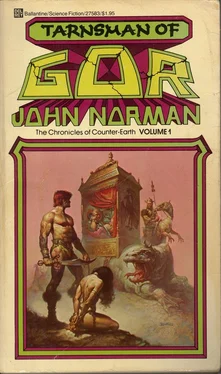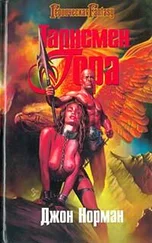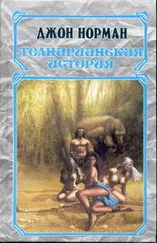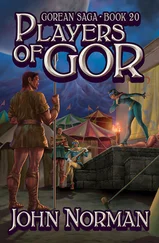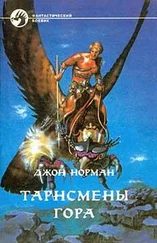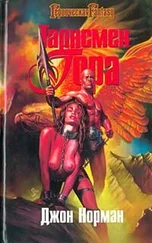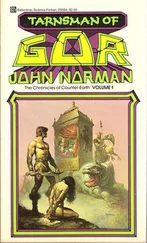I smiled to myself in spite of my fear, amused at the remark I had addressed to myself. It sounded like something out of the Code of the Warrior, something which, if taken literally, would seem to encourage its believer to take not the slightest or most sane precautions for his safety. I blew a note on,the whistle, and it was shrill and different, of a new pitch from that of the Old Tarl.
Almost immediately from somewhere, perhaps from a ledge out of sight, rose a fantastic object, another giant tare, even larger than the first, a glossy sable tam which circled the cylinder once and then wheeled toward me, landing a few feet away, his talons striking on the roof with a sound like hurled gauntlets. His talons were shod with steel — a war tarn. He raised his curved beak to the sky and screamed, lifting and shaking his wings. His enormous head turned toward me, and.his round, wicked eyes blazed in my direction. The next thing I knew his beak was open; I caught a brief sight of his thin, sharp tongue, as long as a man's arm, darting out and back, and then, snapping at me, he lunged forward, striking at me with that monstrous beak, and I heard the Older Tarl cry out in horror, "The goad! The goad!"
I THREW MY RIGHT ARM up to protect myself, the goad, attached by its strap to my wrist, flying wildly. I seized it, using it like a puny stick, striking at the great snapping beak that was trying to seize me, as if I were a scrap of food on the high, flat plate of the cylinder's roof. He lunged twice, and I struck it twice. He drew back his head again, spreading his beak, preparing to slash downward again. In that instant I switched the tare-goad to the «on» position, and when the great beak flashed downward again, I struck it viciously, trying to force it away from me. The effect was startling: there was the sudden bright flash of yellow glittering light, the splash of sparks, and a scream of pain and rage from the tam as he immediately beat his wings, lifting himself out of my reach in a rush of air that nearly forced me over the edge of the roof. I was on my hands and knees, trying to get back on my feet, too near the edge. The tam was circling the cylinder, uttering piercing cries; then he began to fly away from the city.
Without knowing why, and thinking I was better off to have the thing in retreat, I seized my tam whistle and blew its shrill note. The giant bird seemed almost to shudder in the air, and then he reeled, losing altitude, gaining it again. If he had not been simply a winged beast, I would have believed him to be struggling with himself, a creature locked inwardly in mental torture. It was the wild nature of the tarn, the call of the distant hills, the open sky, against the puny conditioning he had been subjected to, against the will of tiny men with their private objectives, their elementary psychology of stimulus and response, their training wires and taro-goads.
At last, with a wild cry of rage, the tam returned to the cylinder. I seized the short mounting ladder swinging wildly from the saddle and climbed it, seating myself in the saddle, fastening the broad purple belt that would keep me from tumbling to my death.
The tarn is guided by virtue of a throat strap, to which are attached, normally, six leather streamers, or reins, which are fixed in a metal ring on the forward portion of the saddle. The reins are of different colors, but one learns them by ring position and not color. Each of the reins attaches to a small ring on the throat strap, and the rings are spaced evenly. Accordingly, the mechanics are simple. One draws on the streamer, or rein, which is attached to the ring most nearly approximating the direction in which one wishes to go. For example, to land or lose altitude, one uses the four-strap which exerts pressure on the four-ring, which is located beneath the throat of the tarn. To rise into flight, or gain altitude, one draws on the one-strap, which exerts pressure on the one-ring, which is located on the back of the tam's neck. The throat-strap rings, corresponding to.the position of the reins on the main saddle ring, are numbered in a clockwise fashion.
The tam-goad also is occasionally used in guiding the bird. One strikes the bird in the direction opposite to which one wishes to go, and the bird, withdrawing from the goad, moves in that direction. There is very little precision in this method, however, because the reactions of the bird are merely instinctive, and he may not withdraw in the exact tangent desired. Moreover, there is danger in using the goad excessively. It tends to become less effective if often used, and the rider is then at the mercy of the taro.
I drew back on the one-strap and, filled with terror and exhilaration, felt the power of the gigantic wings beating on the invisible air. My body lurched wildly, but the saddle belt held. I couldn't breathe for a minute, but clung, frightened and thrilled, to the saddle-ring, my hand wrapped in the one-strap. The tarn continued to climb, and I saw the City of Cylinders dropping far below me, like a set of rounded children's blocks set in the gleaming green hills. I had never experienced anything like this, and if man ever felt godlike I suppose I did in those first savage, exhilarating moments. I looked below and saw the Older Tarl, mounted on his own tarn, climbing to overtake me. When he was near, he shouted to me, the words merry but indistinct in the rush of air.
"Ho, child," he called. "Do you seek to climb to the Moons of Gor?"
I suddenly realized I felt dizzy, or slightly so, but the magnificent black tarn was still climbing, though now struggling, his wings beating fiercely with frustrated persistence against the thinning, less resistant air. The hills and plains of Gor were a blaze of colors far below me, and it may have been my imagination, but it seemed almost as if I could see the curve of the world. I realize now it must have been the thin air and my excitement.
Fortunately, before losing consciousness, I drew on the four-strap, and the tam leveled out and then lifted his wings over his back and dropped like a striking hawk, with a speed that left me without breath in my body. I released the reins, letting them hang on the saddle ring, which is the signal for a constant and straight flight, no pressure on the throat strap. The great tarn snapped his wings out, catching the air under them, and smoothly began to fly a straight course, his wings beating slowly but steadily in a cruising speed that would soon take us far beyond the towers of the city. The Older. Tarl, who seemed pleased, drew near. He pointed back toward the city, which was now several miles in the distance.
"I'll race you," I cried.
"Agreed!" he shouted, wheeling his tam in the instant he spoke, and turning him to the city. I was dismayed. His skill was such that he had taken a lead that it would be impossible to overcome. At last I managed to, turn the bird, and we were streaking along in the wake of the Older Tarl. Certain of his cries drifted back to us. He — a was urging his tarn to greater speed by a series of shouts intended to communicate his own excitement to his winged mount. The thought flashed through my mind that tarns should be trained to respond to voice commands as well as to the numbered straps and the tam-goad. That they had not been seemed astounding to me.
I shouted to my tam, in Gorean and in English. "Har-ta! Har-ta! Faster! Faster!"
The great bird seemed to sense what I intended, or perhaps it was merely his sudden realization that the othertam was in the lead, but a remarkable transformation swept over my sable, plumed steed. His neck straightened and his wings suddenly cracked like whips in the sky; his eyes became fiery and his every bone and muscle seemed to leap with power. In a dizzying minute or two we had passed the Older Tarl, to his amazement, and had settled again in a flurry of wings on the top of the cylinder from which we had departed a few minutes before.
Читать дальше
